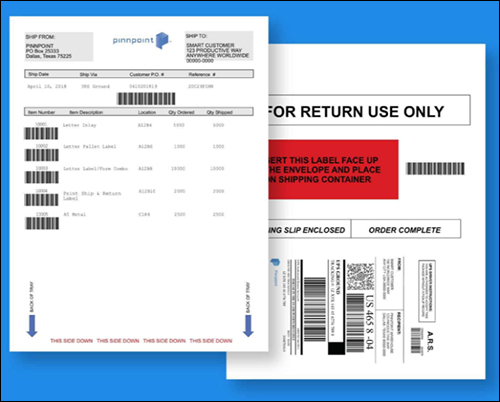Jun 08, 2018Laser printer manufacturer Lexmark has expanded its RFID tag encoding and printing system, and is partnering with companies such as Pinnpoint using Smartrac inlays, as well as its Print, Ship & RFID Return solution. The expansion is part of Lexmark's effort to provide a variety of solutions for what it calls a growing number of potential clients seeking solutions for logistics, as well as work-in-progress (WIP).
Pinnpoint provides forms and labels for use in the new RFID-enabled printer, as well as offering a full solution that includes software and integration services. The labels, typically sheets measuring 8.5 inches by 11 inches, with embedded RFID tags, are designed to be affixed to cartons, pallets, shipping containers or goods being shipped to a customer, or to be packed loose with a product during assembly. Lexmark printers can also support forms from 4 inches by 6 inches up to 8.5 inches by 14 inches, which Pinnpoint can also accommodate.

Pinnpoint has many years of online adhesive label coating experience, says Forrest Steely, the company's CTO and a former Lexmark executive, with proprietary label materials, including face paper as well as adhesive and liners to meet requirements for high-speed laser printing in Lexmark devices. When it comes to the plans with Smartrac, Pinnpoint and Lexmark, "The partnership creates a very cost-efficient industrial solution for printing forms and encoding RAIN RFID inlays," says Amir Mobayen, Smartrac's group CRO.
Lexmark first released its color RFID printers in December 2017 (see Global Printer Manufacturer Adopts RFID for Color Laster Printing). Since that time, the growing demand for the printer has been fueled by several trends, according to John Linton, Lexmark's retail and manufacturing industry director.
The most notable trend is reverse logistics. Brands, logistics providers and retailers are increasingly contending with the return of shipped goods, especially as sales models change. In many cases, Linton says, companies ship multiple product options to customers, such as several sizes or styles of a product. The customer can then make a selection and ship the other products back.
That process opens the opportunity for online purchases, but puts pressure on the logistics providers and brands, and can lead to extra product inventory waiting in receiving areas until the companies can scan in each returned item. By providing an RFID-tagged shipping label for returns, however, a brand or retailer can enable goods to be checked in automatically (with a fixed reader at a portal or a handheld reader used by warehouse personnel), so that they know what goods have been returned, as well as when and where this occurred, in close to real time. In that way, labor hours can be reduced and the products can more quickly be made available for other sales.
Linton says the solution providers with which Lexmark partners, as well as end users, have approached the company indicating that Lexmark printers could enable users to print the return shipping label as each product is packed, and to store the tag's unique ID on that label in the software, along with the product's stock-keeping unit (SKU), so that the goods can be easily identified when returned.
"We partner with a lot of label manufacturers, including Pinnpoint," Linton says. "They are super-aggressive," he states, "and we like that style." Pinnpoint also provides systems integration, which enables Lexmark to sell its printers to end users with a full solution.
Pinnpoint is a label company based in Malmo, Sweden, with U.S headquarters in Dallas, Steely says. The firm was launched four years ago with the introduction of a laser label intended for use with Lexmark printers. In 2017, Pinnpoint developed its reverse logistics laser label, as well as its Print, Ship & RFID Return solution for printing laser labels that can incorporate UHF and NFC RFID inlays. This year, the company partnered with Smartrac and Lexmark with four letter-sized label RFID sheets.
Pinnpoint presently has several pilots under way with companies employing the Lexmark printer with Pinnpoint labels and software to manage RFID tag reads. However, those companies have asked to remain unnamed. For brands and retailers, Steely says, "The way of the future is for shopping [online] to be as frictionless as possible."
One of the Pinnpoint forms consists of a packing list on one side, and the return shipping label on the reverse side. The label is folded in half, and is then inserted into a plastic pouch for return to the shipper. That means users can select the item they want to keep from those that have been shipped, then simply affix the RFID-enabled return label, in its sleeve, to the box and return the other unwanted items. Logistics companies and other businesses are also using the system to print pallet labels that can be attached to a pallet in order to track the location of the products on that pallet.
With regard to WIP, Steely says, the labels are being printed to follow a product as it is assembled, moving through a series of stations or assembly areas where each manufacturing step is accomplished. The label could be attached to a tote in which a product is being transported, so that the label will travel with the product until assembly is completed. The tote can then be reused with a new product and label.
Pinnpoint's RFID labels include either Smartrac's Shortdipole or Dogbone tags. "Additionally," Mobayen says, "the Lexmark device can print and encode our On-Metal Tag, providing Smartrac and its customers with a major, unique value proposition and a significant market advantage."
"Customers can install a laser printer that can easily print labels and forms on demand, on both sides and in color," Mobayen says, "while encoding Smartrac RAIN RFID tags that are a perfect match due to their size and cost." In that way, he explains, "customized shipping labels with an encoded return label can now be produced at a very reasonable price."




